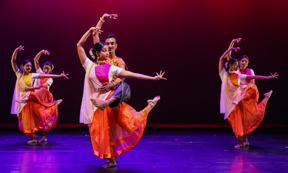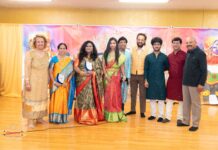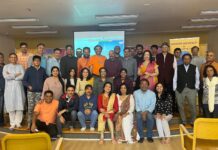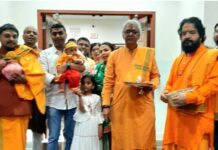
CHICAGO: Natya Dance Theater (NDT) celebrated its 40th year with the world premiere of its “Varna: Colors of White” downtown at The Dance Center of Columbia College October 22 through 24.
Conceived by NDT founder and artistic director Hema Rajagopalan and featuring daughter Krithika Rajagopalan as principal dancer, the full-evening Bharata Natyam performance was based on ancient texts and poems set to original musical scores, bringing to life the spectrum of feelings (rasa, bhava) delineated by Indian aesthetics. The October 24 gala performance featured a one-time-only solo by Hema and public reception.
Lyrics were by Natya Shastra savant Pappu Venugopala Rao, original music by Rajkumar Bharathi, and rhythmic arrangements by mridangam player, G. Vijayaraghavan. Singer Chitrambari Krishnakumar was accompanied by Kalaiarasan Ramanathan violin, Balakrishnan Muthukumar flute, with additional percussion from K.R. Venkatasubramanian. Vinay Srinivasan was the lead male dancer as both Shiva and Buddha.
“Varna” (color) has for its dance-canvas the emergence of worldly multiplicity from an initial dualism, both cosmic and sexual, before reabsorption into the original unity. The opening “Ardhanari” invoked the primordial androgyne as the inseparable complementarity of masculine power and feminine energy through verses from Adi Shankara, Carnatic composer Muttuswami Dikshitar and the resonant Shiva Tandava Stotra attributed to sage Patanjali, author of the Yogasutras.
Whereas Sankhya philosophy outlines a multiplicity of passive male (purusha) principles enmeshed within the all-encompassing web of mother-nature (prakriti), Shiva here was the single dominant male dynamically embracing his own pervasive Shakti (energy), as reflected in her surrounding kaleidoscopic field of multiple female danseuses.
The following group dance further choreographed the ‘profusion’ (prapancham) of “the universe of colors” engendered by the endless interplay of this fertile duality.
“Sita in Reflection” recalls her life with Rama as she pines their definitive separation and the cruelty of her tragic fate. Only some incidents, such as the initial encounter of their mutual gaze just before her swayamvara, were accompanied by sung lyrics, in this instance “who could she be?” (yaaroivaryaaro?) by Arunachala Kavi.
However, Krithika succeeded in vividly and economically conveying many other scenes through representation of both contrasting emotions and dynamic interaction, e.g., her abduction by Ravana.
Transitions were also handled admirably, as when Sita lands listless, almost with a thud, from his winged chariot into her solitary confinement in Lanka.
For the gala-night alone, Hema treated fans to a rare in person interpretation of an ancient poem expressing the intense attachment of a doting mother for her infant son destined to be felled on the battlefield. Hearing rumors that her warrior was killed while fleeing the enemy, she indignantly vows to cut off her nurturing breast if true.
She finally discovers his lifeless body with the spear plunged into his chest, vindicating her as the now proud mother of a hero. By sharply juxtaposing scenes of tender childhood with the savageries of war and by expressing her fears for his future, growing rapidly with his physical stature, Hema transforms this celebration of martyrdom in Tamil Sangam literature into an indictment of fratricidal violence.
This is brought home when the mother frantically turns over corpse after corpse only to recoil in fearful disgust at the sight of untimely death, before she recognizes her son.
“Mara” returned to the theme of multiplicity expressed now through the myriad emotional hues that cloud our ability to recognize truly both other and self. Their dance within is what impels the disguised Indra’s carnal desire for Ahalya, her unsuspecting reciprocity towards her apparent husband, betrayed sage Gautama, whose own fury culminates in their being cursed.
These unruly afflictions of the mind are eventually vanquished and reabsorbed, like a rainbow, back into the ‘whiteness’ of transcendental ‘peace’ (shanta) by the enlightened (Gautama) Buddha. Paradoxical, though, was that Mara’s daughters are depicted also as the seven musical notes and we, the audience, were participating in this reunification through the very seduction of their art.
NDT awarded The Dance Center’s Bonnie Brooks a “Distinguished Services to Dance Arts Award 2015.” As renowned veteran dance critic, Sunil Kothari, who was conferred an NDT lifetime achievement award, observed: over the 40 years since NDT was launched, Hema has evolved a style of Bharata Natyam that remains true to tradition while opening out to contemporary concerns, such as women’s rights, global peace and non-violence.
Longtime partner Ensemble Español, also celebrating its own 40th anniversary, entertained guests with flamenco music and dance during the gala.






